If you’re looking to create a harmonious and positive environment in your space, the shapes and features you choose can make all the difference. In the world of feng shui, concave and convex shapes hold significant meaning and can greatly influence the energy flow in your home or office.
In this article, we’ll explore the differences between concave and convex feng shui and how they can enhance the harmony and positivity in your space. Discover the significance of these shapes and learn how to utilize them effectively.
Key Takeaways:
- Concave and convex shapes hold significant meaning in feng shui.
- These shapes can greatly influence the energy flow in your space.
- By utilizing concave and convex features thoughtfully, you can enhance the harmony and positivity in your environment.
- Learning how to effectively use these shapes can create balance, tranquility, and abundance in your space.
- Experiment with different shapes and find the balance that resonates with your personal feng shui goals.
Understanding Concave and Convex in Feng Shui
If you are new to feng shui, you may have come across the terms “concave” and “convex” and wondered what they mean in this context. In feng shui, these terms refer to the shape of an object or space and its impact on the flow of energy, or chi, in the environment.
The concept of concave and convex shapes in feng shui is rooted in the principle of yin and yang. Yin represents the female, receptive, and introspective energy, while yang represents the masculine, active, and outward energy. Concave shapes are considered yin, as they draw energy inward towards a center point, while convex shapes are considered yang, as they project energy outward.
Understanding the significance of concave and convex shapes in feng shui is essential to creating a harmonious environment that promotes positive energy flow. Below, we will explore the meaning and symbolism of these shapes and how you can use them effectively in your space.
Concave vs Convex in Feng Shui
Concave and convex shapes can have different effects on the energy flow in your environment. Understanding the differences between them is crucial to choosing the right shape for specific areas of your space.
Concave shapes are known for their ability to draw in and collect energy. They are often associated with receptivity, introspection, and calmness. For example, a concave mirror or bowl can reflect and magnify energy, creating a sense of depth and openness. In feng shui, concave shapes are commonly used to enhance the energy of areas associated with rest and relaxation, such as bedrooms, meditation rooms, or living spaces.
On the other hand, convex shapes are known for their ability to project energy outward. They are often associated with expansion, activity, and extroverted energy. For example, convex mirrors or furniture can reflect and project energy, creating a sense of movement and activity. In feng shui, convex shapes are commonly used to enhance the energy of areas associated with productivity, such as home offices or workspaces.
Understanding how concave and convex shapes can influence the energy flow in your environment is the first step to using them effectively in your feng shui practice. By incorporating these shapes thoughtfully, you can create a harmonious and balanced environment that supports your personal goals and aspirations.
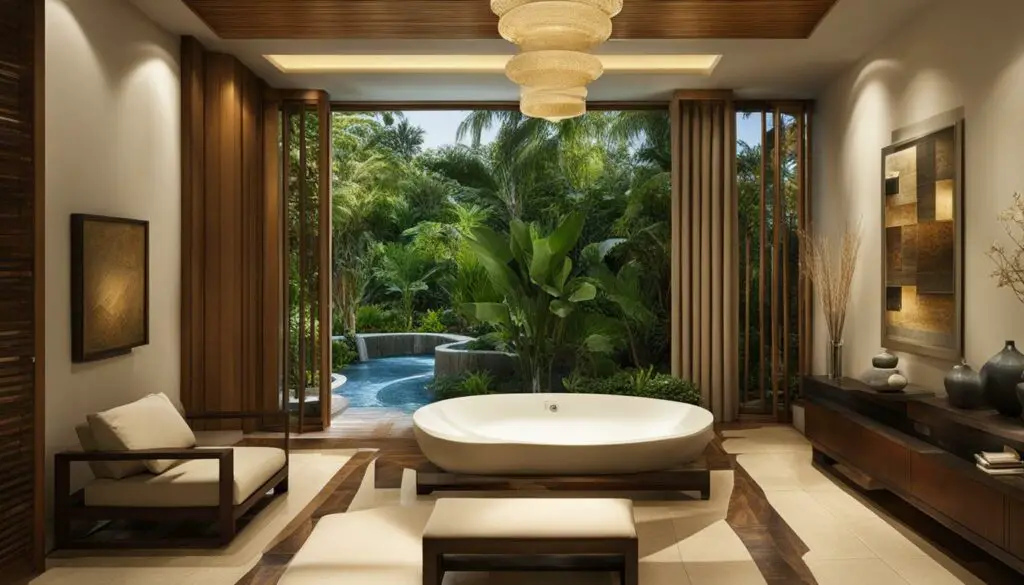
“The concept of concave and convex shapes in feng shui is rooted in the principle of yin and yang. Yin represents the female, receptive, and introspective energy, while yang represents the masculine, active, and outward energy.”
The Significance of Concave and Convex in Feng Shui
The significance of concave and convex shapes in feng shui lies in their ability to create a balance of energy flow. In feng shui, concave shapes are associated with yin energy, which represents receptivity and inward energy flow. Convex shapes, on the other hand, are associated with yang energy, which represents expansion and outward energy flow. The combination of concave and convex shapes can create a sense of harmony and balance, promoting a positive energy flow within a space.
The use of concave and convex shapes in feng shui can help to rectify energy imbalances and enhance the overall energy of a space. For example, in a room that feels overly constricted or stagnant, incorporating convex shapes can help to expand the energy and create a sense of openness. Conversely, in a room that feels overly expansive or chaotic, incorporating concave shapes can help to bring a sense of calmness and inward energy flow.
The Benefits of Using Concave and Convex Shapes in Feng Shui
The use of concave and convex shapes in feng shui can provide a range of benefits for a space and its occupants. Some of the key benefits of using these shapes in feng shui include:
- Creating balance: The combination of concave and convex shapes can help to balance the yin and yang energy within a space, promoting overall harmony and positivity.
- Enhancing energy flow: By utilizing concave and convex shapes effectively, you can optimize the energy flow within a space, promoting a sense of calmness, clarity, and productivity.
- Rectifying energy imbalances: Incorporating concave and convex shapes can help to correct energy imbalances within a space, promoting a sense of harmony and balance.
- Enhancing aesthetics: The use of concave and convex shapes can enhance the overall aesthetics of a space, creating a visually engaging and dynamic environment.
The Role of Concave and Convex Shapes in Feng Shui Practice
In feng shui practice, the use of concave and convex shapes is considered an essential technique for enhancing the overall energy of a space. By understanding the significance of these shapes and their impact on energy flow, you can utilize them effectively and promote a sense of balance and positivity within your environment.
Whether you are incorporating concave and convex shapes through furniture, architectural design, or decorative accents, it’s important to keep their significance in mind and utilize them thoughtfully. By doing so, you can enhance the energy flow of your space and create a harmonious and balanced environment that promotes wellbeing and prosperity.
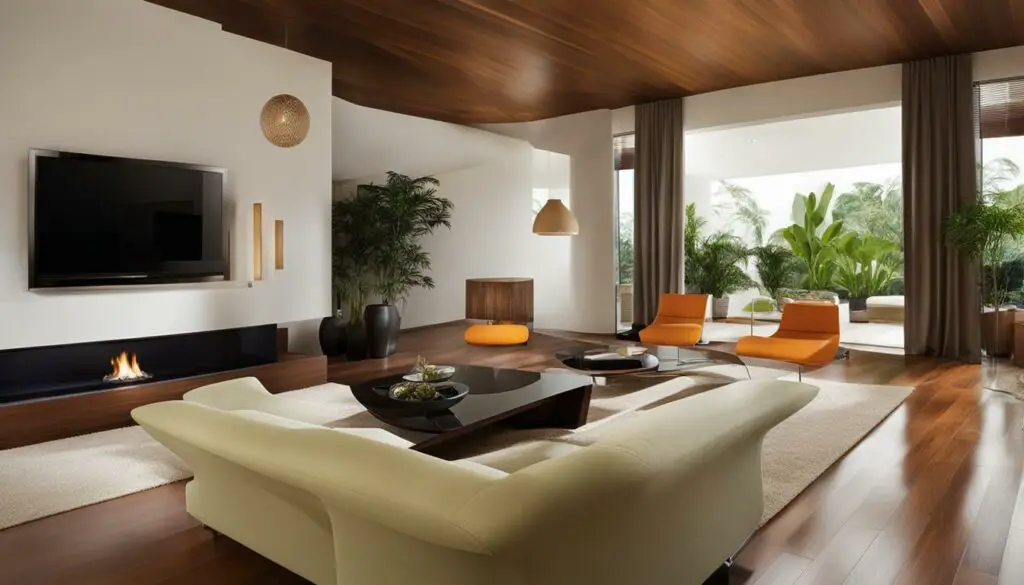
Concave and Convex Shapes in Feng Shui
Concave and convex shapes play a significant role in feng shui practices, as they represent yin and yang energies respectively. In feng shui, concave shapes are associated with the energy of receptivity, introspection, and containment, while convex shapes reflect expansion, openness, and abundance.
When it comes to incorporating concave and convex shapes in your space, you have numerous options to choose from. Here are some popular concave and convex shapes that are used in feng shui:
| Concave Shapes | Convex Shapes |
|---|---|
| Round or oval mirrors | Round or oval tables |
| Bowls or vases | Circular rugs or carpets |
| Crescent-shaped furniture | Arch-shaped doorways or windows |
| Niche or alcove in walls | Roof with a dome-like shape |
When selecting furniture or decor for your space, consider incorporating concave and convex shapes in a balanced way. For instance, if you have a predominantly angular or sharp-shaped room, compensate with some round or curved elements. Similarly, if your space feels closed or cramped, consider adding convex shapes to create a sense of flow and spaciousness.
Remember that the key to harmonious feng shui is balance and moderation. Avoid overloading your space with too many concave or convex shapes, as this may create an imbalance in energy. Instead, aim for a cohesive and aesthetically pleasing mix of shapes that promotes positive energy flow.
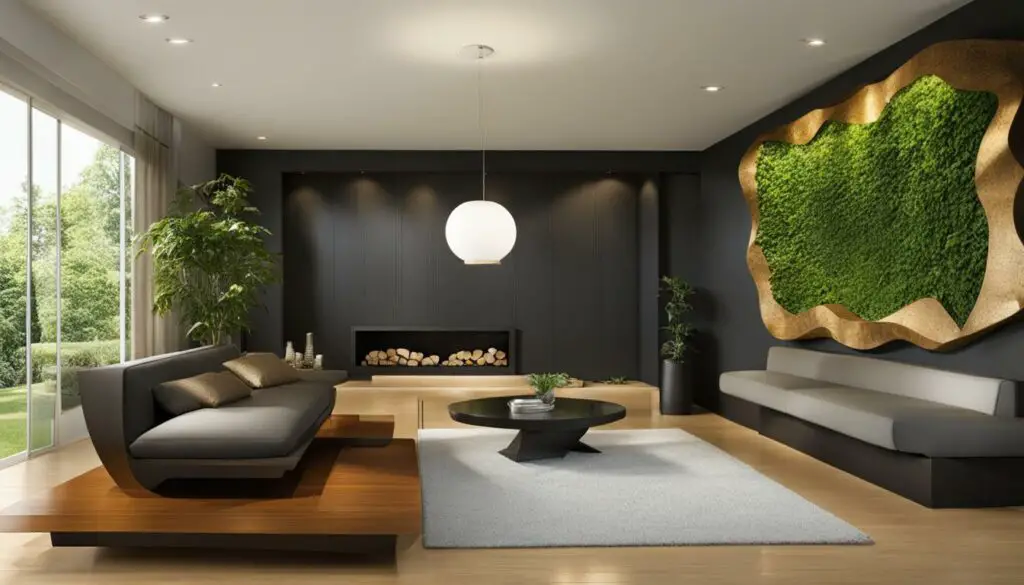
Using Concave and Convex in Feng Shui
Now that we understand the significance of concave and convex shapes in feng shui, let’s explore how to use them effectively in your space. By incorporating these shapes thoughtfully, you can optimize the flow of energy and create a harmonious environment that promotes positivity, tranquility, and balance.
Here are some practical tips for utilizing concave and convex shapes in your feng shui practice:
- Use concave shapes, such as bowls or vases, to create a sense of inward energy flow and calmness in your space. Place them in areas where you want to promote relaxation and introspection.
- Incorporate convex shapes, such as mirrors or furniture with curved edges, to expand the energy in your space and create a sense of openness and abundance. Place them in areas where you want to promote socialization and activity.
- Experiment with different shapes and sizes to find the right balance for your space. Incorporate multiple concave and convex elements in a room to create a balanced energy flow.
- Consider the placement of your concave and convex shapes. For example, avoid placing convex mirrors facing the entrance door as it can reflect the positive energy out of your space.
- When using convex mirrors, make sure they reflect something beautiful and positive, such as a piece of art or a plant.
- Use concave and convex shapes in outdoor spaces such as in landscaping or garden design. Incorporating these shapes can enhance the energy flow and create a harmonious connection between the indoor and outdoor environments.
By following these tips, you can successfully integrate concave and convex shapes into your feng shui practice and optimize energy flow in your space.
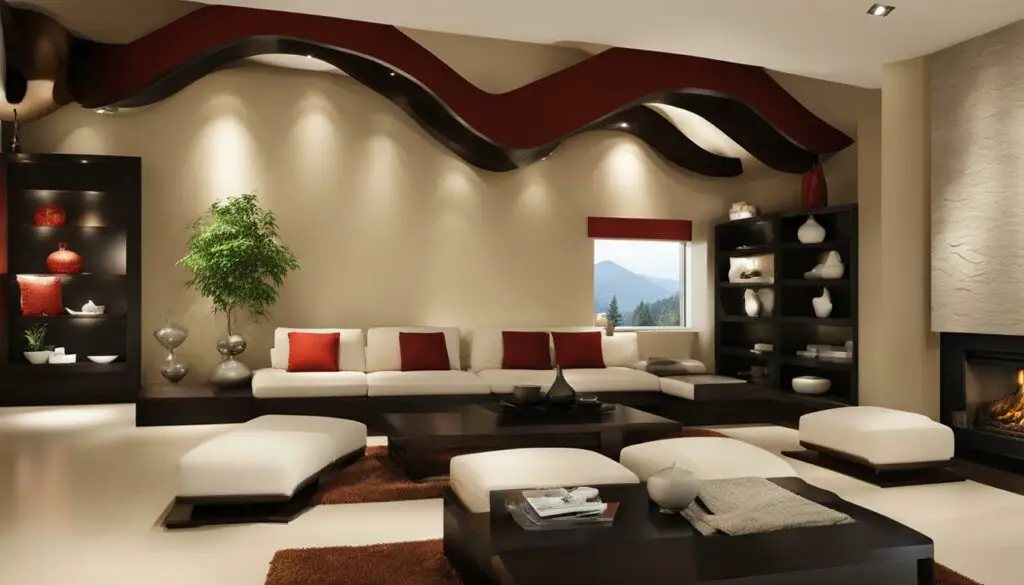
Concave vs Convex in Feng Shui Analysis
When it comes to feng shui, the analysis of concave vs convex shapes is an important consideration. Concave shapes are said to draw energy inward, while convex shapes push energy outward. Depending on the room and the desired effect, you may choose to incorporate one or both of these shapes into your space.
For example, in a bedroom, a concave headboard can promote relaxation and calmness, while a convex mirror can expand the energy and promote wakefulness. In a living room, a concave couch can create a sense of togetherness and intimacy, while a convex coffee table can bring a sense of abundance and openness.
It’s important to remember that the placement of these shapes is just as important as the shapes themselves. A concave feature placed in the wrong area can create a sense of depression or inwardness, while a convex feature placed in the wrong area can create a sense of chaos or scattered energy.

When analyzing the use of concave vs convex shapes in your space, consider the overall balance you want to achieve. Too much of one shape can create an imbalance, while balancing both shapes can create a sense of harmony and flow.
Examples of Concave vs Convex in Feng Shui Analysis
| Concave Features | Convex Features |
|---|---|
| Concave headboard in a bedroom | Convex mirror in a living room |
| Concave couch in a living room | Convex coffee table in a living room |
| Concave artwork in an office | Convex shelf in a kitchen |
As you can see, there are many ways to incorporate concave and convex features into your space to enhance the energy flow and promote a harmonious environment. By considering the analysis of these shapes and their placement, you can make the most of your feng shui practice and create a space that supports your overall wellbeing.
Enhancing the Positive Energy with Concave Features in Feng Shui
Concave features in feng shui are known for their ability to create a sense of inward energy flow, promoting calmness and introspection. By incorporating concave elements into your space, you can enhance the energy flow and create a nurturing environment that supports relaxation and tranquility.
One way to incorporate concave features into your space is through the use of bowls or vases. These curved shapes encourage a sense of inward energy flow, making them ideal for areas of your home where you want to create a calming and nurturing environment.
| Concave Features in Feng Shui | Placement Recommendation |
|---|---|
| Bowls or Vases | Living Room or Bedroom |
| Concave Mirrors | Bathroom or Entryway |
| Curved Furniture | Reading Corner or Meditation Space |
Another way to utilize concave features is through the use of mirrors. Placing a concave mirror in your bathroom or entryway can help to redirect energy flow, creating a more positive and harmonious environment.
Curved furniture is another great way to incorporate concave elements into your space. From a rounded sofa to a curved-backed chair, these shapes can create a sense of intimacy and promote relaxation. Consider incorporating these pieces into your reading corner or meditation space for a peaceful escape within your home.
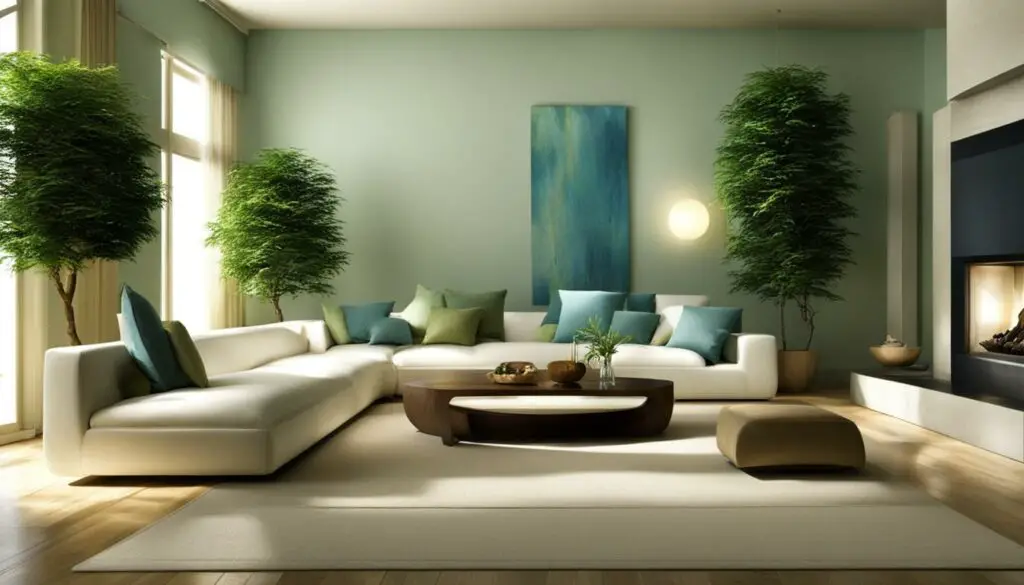
By incorporating concave features into your space, you can enhance the positive energy and create a sense of calm and introspection. Experiment with different shapes and placements to find the perfect balance for your personal feng shui goals.
Creating Balance with Convex Features in Feng Shui
Convex features are an essential component of feng shui, as they can create balance and harmony in your space. These shapes represent the yang energy, which is expansive and outgoing, and can help to bring in a sense of openness and abundance.
One of the most common convex features used in feng shui is a convex mirror. Placing a convex mirror in your space can help to expand the energy and create a sense of depth. It can also reflect and magnify positive energy, making it an excellent addition to any room.
When it comes to furniture, incorporating curved or rounded pieces can also help to bring in the yang energy. A round coffee table, for example, can create a more open and free-flowing feel to your living room.
| Convex Features in Feng Shui | Benefits |
|---|---|
| Convex mirror | -Expands energy -Magnifies positive energy -Creates a sense of depth |
| Curved or rounded furniture | -Brings in yang energy -Adds a sense of flow |
Overall, incorporating convex features can help to create balance and harmony in your space. However, it is important to strike a balance between convex and concave shapes, as they both play a significant role in feng shui. By finding the right balance of these shapes, you can create a space that promotes positive energy and supports your personal well-being.
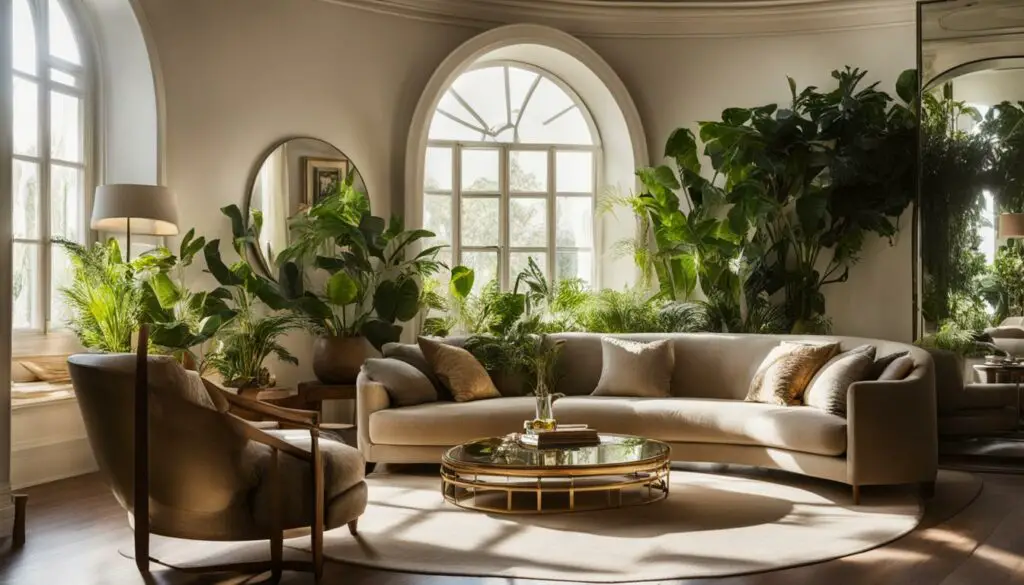
Feng Shui Tips for Using Concave and Convex Shapes
When it comes to using concave and convex shapes in your feng shui practice, there are several tips and strategies you can utilize to optimize the energy flow and create a harmonious environment. Here are some practical recommendations:
Understand the Purpose
Before incorporating concave and convex shapes into your space, it’s important to understand their purpose. Concave shapes draw energy inward, promoting calmness and introspection, while convex shapes expand energy, bringing in openness and abundance. Consider the intention of the specific area and choose shapes that align with your desired energy flow.
Placement Techniques
The placement of concave and convex shapes is crucial to their effectiveness in feng shui. For example, concave mirrors can be placed in entryways to draw positive energy into the space, while convex mirrors can be placed in corners to expand the energy flow. When using furniture with concave or convex elements, ensure it is placed in a way that promotes balance and harmony.
Balance Yin and Yang
Find the balance between yin and yang by pairing concave and convex shapes. For example, a room with predominantly convex elements can benefit from incorporating concave accents to bring in a sense of calmness and balance. Similarly, a space with mostly concave shapes can benefit from adding convex elements to promote openness and abundance.
Choose the Right Materials
When selecting materials for concave and convex shapes, it’s important to consider their texture and color. Smooth and reflective surfaces are ideal for convex shapes, while concave shapes benefit from soft and matte textures. Additionally, consider incorporating colors that align with the specific intention of the space.
Experiment and Personalize
Remember that feng shui is a personal practice, and what works for one space may not work for another. Experiment with different concave and convex shapes and trust your intuition when it comes to their placement and purpose. Personalize your space with elements that resonate with you and support your desired energy flow.
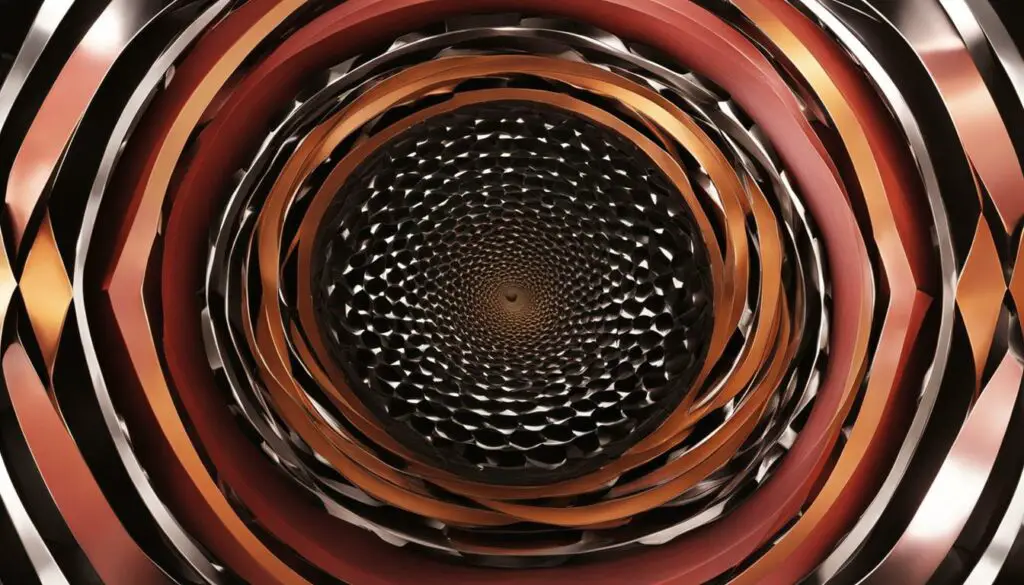
Incorporating concave and convex shapes in your feng shui practice can bring balance, harmony, and positivity to your environment. By understanding their purpose, utilizing placement techniques, balancing yin and yang, selecting the right materials, and personalizing your space, you can enhance the energy flow and create a space that supports your well-being.
Incorporating Concave and Convex Shapes in Interior Design
When it comes to interior design, concave and convex shapes offer a unique and intriguing way to enhance the energy flow in your space. By incorporating these shapes in your decor, you can create a sense of balance and harmony while also adding visual interest to your surroundings.
One way to incorporate concave and convex shapes in interior design is through your furniture selection. Look for pieces with curved edges or rounded shapes, such as a concave sofa or a convex ottoman. These pieces not only add a sense of flow to the room but also serve as a focal point of conversation.
Another option is to add decorative accents with concave and convex shapes. For example, a convex mirror can create the illusion of a larger space while also reflecting light and energy throughout the room.
When using these shapes in your design, it’s important to consider the overall balance and symmetry of the room. Incorporating too many curvatures can create a chaotic energy flow, so be sure to balance out convex and concave pieces throughout the space.

Finally, consider using lighting to highlight the unique features of concave and convex shapes. With the right technique, you can enhance the shadows and highlights of these shapes to create a stunning visual impact in your space.
Finding Balance: Combining Concave and Convex in Feng Shui
When it comes to using concave and convex shapes in feng shui, it’s important to find a balance between the two. While both shapes have their unique properties, they also complement each other, creating a harmonious environment.
One way to achieve balance is by understanding the yin and yang principles. Yin represents the feminine energy and is linked to concave shapes, while yang represents the masculine energy and is associated with convex shapes. By combining these energies, you can create a balanced and prosperous environment.
The Benefits of Combining Concave and Convex Shapes
Combining concave and convex shapes can create a sense of flow and movement in your space. It can also bring in opposing energies, creating balance and harmony. For example, if you have a concave space, such as a sunken living room, adding convex furniture, such as a round coffee table, can balance the energy and create a more harmonious environment.
Additionally, combining these shapes can enhance the aesthetic appeal of your space. It can create visual interest and add dimension, making your environment more engaging and inviting.
Choosing the Right Balance for Your Space
When it comes to choosing the right balance between concave and convex shapes, it’s important to consider the specific needs of your space. Start by evaluating the energy flow and identifying areas that need enhancement.
For example, if you have a room with stagnant energy, adding a convex mirror can help to expand the energy and bring in more light. Alternatively, if you have a space that feels overwhelming, adding concave elements, such as a cozy chair or a bowl, can create a sense of inward energy flow and promote relaxation.
Experiment with Different Shapes
Experimenting with different shapes is an essential part of finding the perfect balance between concave and convex elements. Don’t be afraid to try new things and see what works best for your space.
Use the image below as a guide to understand the different concave and convex shapes and how they can be used together. Incorporate these shapes into your space and observe the changes in the energy flow. Keep in mind that finding the perfect balance may take some time, so be patient and enjoy the process of creating a harmonious environment.

Incorporating concave and convex shapes is an effective way to enhance the energy flow and create a harmonious environment. Whether you’re looking to promote relaxation, expand the energy, or simply add visual interest, combining these shapes can help you achieve your feng shui goals.
Expanding Space Energy with Convex Feng Shui
Convex shapes are known for their ability to expand energy and create a sense of openness and abundance. In feng shui, these shapes are used to enhance the flow of positive energy and promote a harmonious environment.
One of the most common convex elements used in feng shui is the convex mirror. These mirrors are believed to deflect negative energy and expand the flow of positive energy in a space. Place a convex mirror in an area that receives natural light to amplify its energy-boosting effects.
Convex furniture is another way to incorporate these shapes into your space. From curved sofas to rounded coffee tables, these pieces can create a sense of flow and movement in a room, promoting positive energy and harmony.
When choosing convex elements for your space, it’s important to consider their placement. Convex shapes should be used in areas that require a boost of energy or need to create a sense of openness. Avoid using convex shapes in tight or enclosed spaces, as they may disrupt the flow of energy and create a feeling of constriction.
| Pros of Convex Feng Shui | Cons of Convex Feng Shui |
|---|---|
|
|

Overall, incorporating convex shapes in your feng shui practice can expand the energy flow in your space and create a harmonious and abundant environment. Whether using convex mirrors or furniture, consider the placement and balance of these elements to optimize their positive effects.
Creating a Sense of Inward Energy with Concave Feng Shui
In feng shui, concave shapes are associated with the yin energy, as they represent receptivity, inwardness, and calmness. They are often used to create a sense of intimacy, protection, and nurturing energy flow within a space, promoting relaxation and introspection.
One of the most common ways to incorporate concave elements in feng shui is through the use of mirrors. Mirrors are believed to be one of the most powerful feng shui tools, and when they are concave, their effect is even more pronounced. A concave mirror can create a sense of depth, reflecting and amplifying the energy flow while also drawing it inward.
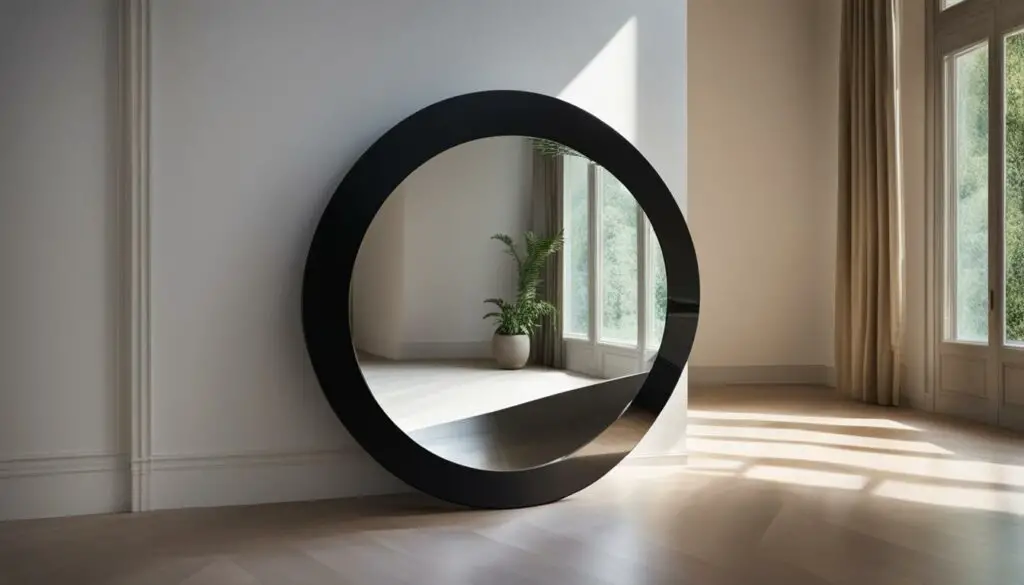
Another way to use concave elements is through furniture and decor. For example, a concave table or chair can create a cozy and inviting atmosphere, perfect for a nurturing environment such as a bedroom or a meditation room. Bowls and vases with concave shapes are also common in feng shui, as they can hold and amplify the energy of the items they contain, promoting a sense of grounding and inward flow.
Examples of Concave Elements in Feng Shui
| Element | Meaning |
|---|---|
| Concave mirrors | Create a sense of depth and inward flow |
| Concave furniture | Provide comfort and a sense of intimacy |
| Bowls and vases | Hold and amplify energy, promoting grounding and inward flow |
When using concave elements in feng shui, it’s important to balance them with convex shapes to create a sense of harmony and balance. As with all feng shui practices, the key is to experiment and find what works best for your personal needs, goals, and preferences.
Incorporating Concave and Convex in Outdoor Spaces
Outdoor spaces offer unique opportunities for incorporating concave and convex features to enhance the energy flow and create a harmonious environment. By bringing the principles of feng shui outdoors, you can create a seamless connection between your indoor and outdoor spaces and promote a sense of balance and tranquility.
One way to incorporate concave and convex shapes in your outdoor space is through landscaping. Consider adding curved paths, hedges, or flower beds to create a sense of inward energy flow. Use convex elements, such as sculptures or fountains, to expand the energy and create a sense of openness.
In architectural design, incorporating concave and convex elements in your outdoor space can create a visually appealing and harmonious environment. Use curved walls or windows to create a sense of fluidity and movement. Incorporate convex elements in the form of seating areas or outdoor furniture to expand the energy and create a welcoming and abundant atmosphere.
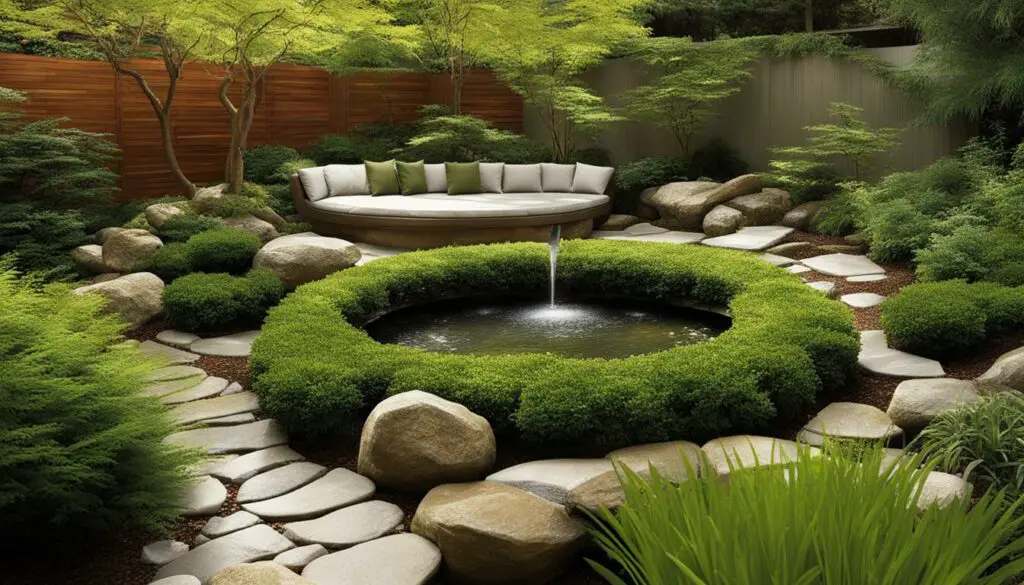
When incorporating concave and convex features in your outdoor space, it’s essential to consider the overall balance and harmony of the area. Ensure that the shapes are appropriately placed and scaled, creating a sense of balance and contributing to the energy flow of the space.
Achieving Harmony: The Power of Concave and Convex in Feng Shui
Concave and convex shapes are powerful tools in feng shui that can enhance the harmony and positive energy in your space. Understanding their significance and learning how to incorporate them effectively can unlock the full potential of your environment.
By utilizing concave shapes, you can create a sense of inward energy flow that promotes calmness, introspection, and a nurturing environment. Incorporating convex shapes, on the other hand, can expand the energy in your space, bringing in a sense of openness and abundance.
But it’s not just about using one shape over the other. Instead, finding the right balance between concave and convex elements is crucial in achieving overall harmony and balance. Incorporating both shapes thoughtfully can help balance the yin and yang energies in your space, creating a nourishing and prosperous environment.
At the heart of it all, concave vs convex feng shui is not a debate, but rather an opportunity to explore the power of shapes in enhancing the energy flow and promoting overall well-being. So, experiment with different shapes and find the balance that resonates with your personal feng shui goals.

Conclusion
Concave vs convex feng shui is an important debate that highlights the significance of shapes in creating a harmonious and positive environment. By understanding the differences between these shapes and their symbolic meanings, you can effectively utilize them to enhance the flow of energy in your space.
Whether you prefer concave or convex elements, it’s important to find the right balance that resonates with your personal feng shui goals. Experiment with different shapes, and consider incorporating both concave and convex elements to achieve a harmonious and balanced environment.
Remember to consider the principles of yin and yang when incorporating these shapes, and always strive for a balance between the two. By doing so, you can create a nurturing, positive space that supports your well-being and prosperity.
FAQ
What is the difference between concave and convex feng shui?
In feng shui, concave shapes are associated with inward energy flow, promoting calmness and introspection. Convex shapes, on the other hand, expand energy and create a sense of openness and abundance.
How can concave and convex shapes enhance harmony in my space?
Incorporating concave and convex shapes thoughtfully can optimize the energy flow in your environment, creating a harmonious and balanced space.
What is the significance of concave and convex features in feng shui?
Concave and convex features are considered important in feng shui as they can create balance and harmony, promote positive energy flow, and influence the overall energy of a space.
What are some common concave and convex shapes used in feng shui?
Curved furniture, architectural elements, concave mirrors, convex mirrors, and bowls are some examples of concave and convex shapes commonly used in feng shui practices.
How can I effectively use concave and convex shapes in my feng shui practice?
Practical tips for using concave and convex shapes include properly placing them in specific areas of your space, considering the yin and yang principles, and ensuring a balanced combination of both shapes.
What are the different effects of concave and convex shapes on energy flow?
Concave shapes create inward energy flow and promote calmness, while convex shapes expand energy, create openness, and bring in a sense of abundance.
How can concave features enhance positive energy in my space?
Incorporating concave features like concave mirrors or bowls can create a sense of inward energy flow, promoting a nurturing atmosphere and encouraging relaxation and introspection.
How can convex features create balance in feng shui?
Convex features, such as convex mirrors or furniture, can expand energy and create balance by bringing in a sense of openness and abundance.
What are some feng shui tips for using concave and convex shapes?
Feng shui tips for using concave and convex shapes include considering the specific recommendations for each room, following general guidelines for balance, and experimenting to find what resonates with your personal goals.
How can concave and convex shapes be incorporated into interior design?
Concave and convex shapes can be integrated into interior design through careful furniture selection, incorporating decorative accents, and considering the overall aesthetics and energy of your space.
How do concave and convex shapes work together in feng shui analysis?
Combining concave and convex elements in feng shui analysis involves understanding the yin and yang principles and finding the right balance between these shapes to create a harmonious and balanced environment.
How can convex feng shui expand energy in my space?
Convex feng shui can expand energy by using convex shapes to create a sense of openness and abundance, positively impacting the flow of energy in your environment.
How can concave feng shui create a sense of inward energy flow?
Concave feng shui creates a sense of inward energy flow by using concave shapes to promote calmness, introspection, and a nurturing environment that supports relaxation and introspection.
How can concave and convex elements be incorporated into outdoor spaces?
From landscaping to architectural design, concave and convex elements can be incorporated into outdoor spaces to enhance the energy flow and create a harmonious connection between your indoor and outdoor environments.
What is the overall power of concave and convex shapes in feng shui?
Concave and convex shapes have the power to enhance the harmony and positive energy in your space. By harnessing the energy of these shapes, you can create a balanced and prosperous environment.
What is the significance of understanding concave vs convex feng shui?
Understanding the difference between concave and convex feng shui shapes is important in creating a harmonious space and optimizing the energy flow. It allows you to make informed decisions when incorporating these shapes into your environment.
How do I find the right balance between concave and convex elements in feng shui?
Finding the right balance between concave and convex elements involves understanding the yin and yang principles, considering the specific effects of each shape, and experimenting to create a harmonious and balanced environment.
How can concave feng shui enhance the positive energy in my space?
Concave feng shui can enhance positive energy by creating a sense of inward energy flow, promoting calmness, introspection, and a nurturing environment.
How can convex feng shui create balance in my space?
Convex feng shui creates balance by expanding energy, creating openness, and bringing in a sense of abundance.
What are some practical feng shui tips for using concave and convex shapes?
Practical feng shui tips for using concave and convex shapes include considering specific room recommendations, following general guidelines for balance, and experimenting to find what resonates with your personal feng shui goals.
How can concave and convex shapes be incorporated into interior design?
Concave and convex shapes can be integrated into interior design through careful furniture selection, incorporating decorative accents, and considering the overall aesthetics and energy of your space.
How do concave and convex shapes work together in feng shui analysis?
Combining concave and convex elements in feng shui analysis involves understanding the yin and yang principles and finding the right balance between these shapes to create a harmonious and balanced environment.
How can convex feng shui expand energy in my space?
Convex feng shui can expand energy by using convex shapes to create a sense of openness and abundance, positively impacting the flow of energy in your environment.
How can concave feng shui create a sense of inward energy flow?
Concave feng shui creates a sense of inward energy flow by using concave shapes to promote calmness, introspection, and a nurturing environment that supports relaxation and introspection.
How can concave and convex elements be incorporated into outdoor spaces?
From landscaping to architectural design, concave and convex elements can be incorporated into outdoor spaces to enhance the energy flow and create a harmonious connection between your indoor and outdoor environments.
What is the overall power of concave and convex shapes in feng shui?
Concave and convex shapes have the power to enhance the harmony and positive energy in your space. By harnessing the energy of these shapes, you can create a balanced and prosperous environment.
What is the significance of understanding concave vs convex feng shui?
Understanding the difference between concave and convex feng shui shapes is important in creating a harmonious space and optimizing the energy flow. It allows you to make informed decisions when incorporating these shapes into your environment.
How do I find the right balance between concave and convex elements in feng shui?
Finding the right balance between concave and convex elements involves understanding the yin and yang principles, considering the specific effects of each shape, and experimenting to create a harmonious and balanced environment.
How can concave feng shui enhance the positive energy in my space?
Concave feng shui can enhance positive energy by creating a sense of inward energy flow, promoting calmness, introspection, and a nurturing environment.
How can convex feng shui create balance in my space?
Convex feng shui creates balance by expanding energy, creating openness, and bringing in a sense of abundance.
What are some practical feng shui tips for using concave and convex shapes?
Practical feng shui tips for using concave and convex shapes include considering specific room recommendations, following general guidelines for balance, and experimenting to find what resonates with your personal feng shui goals.
How can concave and convex shapes be incorporated into interior design?
Concave and convex shapes can be integrated into interior design through careful furniture selection, incorporating decorative accents, and considering the overall aesthetics and energy of your space.
How do concave and convex shapes work together in feng shui analysis?
Combining concave and convex elements in feng shui analysis involves understanding the yin and yang principles and finding the right balance between these shapes to create a harmonious and balanced environment.
How can convex feng shui expand energy in my space?
Convex feng shui can expand energy by using convex shapes to create a sense of openness and abundance, positively impacting the flow of energy in your environment.
How can concave feng shui create a sense of inward energy flow?
Concave feng shui creates a sense of inward energy flow by using concave shapes to promote calmness, introspection, and a nurturing environment that supports relaxation and introspection.
How can concave and convex elements be incorporated into outdoor spaces?
From landscaping to architectural design, concave and convex elements can be incorporated into outdoor spaces to enhance the energy flow and create a harmonious connection between your indoor and outdoor environments.
What is the overall power of concave and convex shapes in feng shui?
Concave and convex shapes have the power to enhance the harmony and positive energy in your space. By harnessing the energy of these shapes, you can create a balanced and prosperous environment.
What is the significance of understanding concave vs convex feng shui?
Understanding the difference between concave and convex feng shui shapes is important in creating a harmonious space and optimizing the energy flow. It allows you to make informed decisions when incorporating these shapes into your environment.
How do I find the right balance between concave and convex elements in feng shui?
Finding the right balance between concave and convex elements involves understanding the yin and yang principles, considering the specific effects of each shape, and experimenting to create a harmonious and balanced environment.
How can concave feng shui enhance the positive energy in my space?
Concave feng shui can enhance positive energy by creating a sense of inward energy flow, promoting calmness, introspection, and a nurturing environment.
How can convex feng shui create balance in my space?
Convex feng shui creates balance by expanding energy, creating openness, and bringing in a sense of abundance.
What are some practical feng shui tips for using concave and convex shapes?
Practical feng shui tips for using concave and convex shapes include considering specific room recommendations, following general guidelines for balance, and experimenting to find what resonates with your personal feng shui goals.
How can concave and convex shapes be incorporated into interior design?
Concave and convex shapes can be integrated into interior design through careful furniture selection, incorporating decorative accents, and considering the overall aesthetics and energy of your space.
How do concave and convex shapes work together in feng shui analysis?
Combining concave and convex elements in feng shui analysis involves understanding the yin and yang principles and finding the right balance between these shapes to create a harmonious and balanced environment.
How can convex feng shui expand energy in my space?
Convex feng shui can expand energy by using convex shapes to create a sense of openness and abundance, positively impacting the flow of energy in your environment.
How can concave feng shui create a sense of inward energy flow?
Concave feng shui creates a sense of inward energy flow by using concave shapes to promote calmness, introspection, and a nurturing environment that supports relaxation and introspection.
How can concave and convex elements be incorporated into outdoor spaces?
From landscaping to architectural design, concave and convex elements can be incorporated into outdoor spaces to enhance the energy flow and create a harmonious connection between your indoor and outdoor environments.
What is the overall power of concave and convex shapes in feng shui?
Concave and convex shapes have the power to enhance the harmony and positive energy in your space. By harnessing the energy of these shapes, you can create a balanced and prosperous environment.

